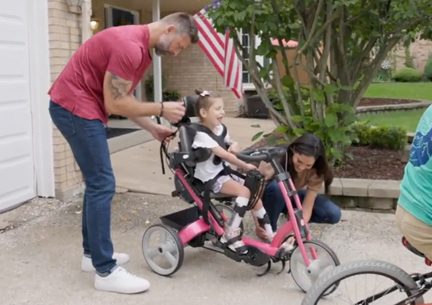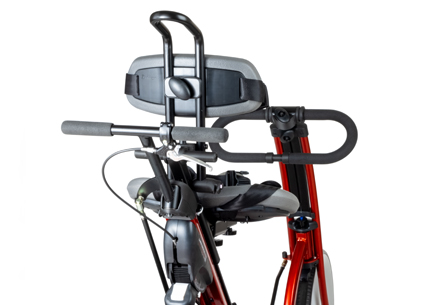Ingenious Solutions from the Field
Using the Rifton TRAM to Transfer onto a Tricycle
| June 2016|
1. Position student at corner of mat table and bring TRAM in from the back. |
2. Fasten trunk support and using leg straps, lift student. |
|
3. Roll TRAM with student in it to the back of the tricycle. |
4. Lower student onto tricycle. |
The Story Behind Our Innovation
I work in school settings, and I have one middle school student who was previously ambulatory with hemiplegic cerebral palsy. She subsequently had a stroke that left her unable to walk with the cerebral palsy of the spastic quadriplegia variety. She was able to ride her tricycle at home (we were told) but wanted to ride at school. But she was unable to both maintain a crouched standing position and pivot for transfers, and even if she could, her crouched standing places her too low for the tricycle seat height. The task simply required standing and weight shifting beyond her ability, and we were unable to safely transfer her onto the trike. Manually lifting her was not an option because she is too large.
We were already using the Rifton TRAM in the classroom for other transfers, and I wondered if we might be able to use it to place her onto her tricycle- if we faced her BACKWARDS and in the TRAM. Coming directly from her wheelchair, there is no way to do this; but, because she has good sitting balance, we discovered that by lifting her first from her wheelchair to the corner of a mat table, we could release her and bring the TRAM around behind her from an angle and lift her from the posterior position.
We did a dry run with the student watching, with me sitting on the corner of the mat table (shown in the series of pictures illustrating the transfer) and with her special education teacher coming up behind me and fastening me into the TRAM facing backwards. We used the thigh straps to lift me up in a sitting position, and her teacher then rolled the TRAM to the back of the tricycle and lowered me directly onto the seat. It worked beautifully for me, so we tried it with my student- and it went flawlessly.
She proceeded to ride the tricycle triumphantly to the cafeteria, where she rode three loops around, and then to the gym, where she rode five loops around, all independently, including her steering. I was amazed; I would not have imagined she could have done this given her degree of impairment.
In the past, the extent of her “exercise” was her PE class which she attended while remaining in her power wheelchair—good for socialization, but not for exercise. Now, she rides the tricycle five days a week instead of sitting in PE class. A classmate jogs alongside her, and she is so proud to show off her biking-riding skills to others. All this was made possible by the TRAM.
Note from Rifton: Yes, we did try this with our Rifton trikes. It worked on all three sizes. Our first step was to temporarily remove the backrest (trunk support) from the trike. So it would probably take two caregivers once the transfer has been made; one to hold the child in a sitting position on the trike seat, and the other to remove the TRAM and replace the backrest.








